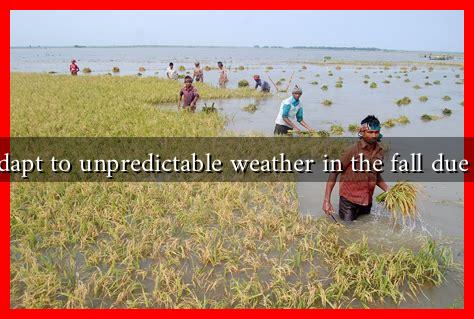-
Table of Contents
- How Do Farmers Adapt to Unpredictable Weather in the Fall Due to Climate Change?
- Understanding the Impact of Climate Change on Fall Weather
- Adaptive Strategies Employed by Farmers
- 1. Crop Diversification
- 2. Improved Water Management
- 3. Utilizing Technology
- 4. Crop Insurance and Financial Planning
- Case Studies: Successful Adaptation in Action
- Conclusion: The Path Forward
How Do Farmers Adapt to Unpredictable Weather in the Fall Due to Climate Change?
Climate change has emerged as one of the most pressing challenges facing agriculture today. As global temperatures rise and weather patterns become increasingly erratic, farmers are finding it essential to adapt their practices to ensure sustainable production. The fall season, traditionally a time for harvest, has become particularly unpredictable, with extreme weather events such as droughts, floods, and early frosts posing significant risks. This article explores the various strategies farmers employ to navigate these challenges and maintain productivity in the face of climate change.
Understanding the Impact of Climate Change on Fall Weather
The fall season is critical for farmers as it marks the culmination of a year’s worth of labor. However, climate change has led to:
- Increased frequency of extreme weather events.
- Shifts in growing seasons, affecting crop maturity.
- Unpredictable rainfall patterns, leading to droughts or flooding.
- Higher temperatures, which can stress crops and reduce yields.
According to the National Oceanic and Atmospheric Administration (NOAA), the United States has experienced a 1.8°F increase in average temperature since 1901, with projections indicating further increases. This warming trend has profound implications for agricultural practices, particularly in the fall.
Adaptive Strategies Employed by Farmers
Farmers are not passive victims of climate change; they are actively seeking ways to adapt their practices. Here are some of the most common strategies:
1. Crop Diversification
Diversifying crops can mitigate the risks associated with unpredictable weather. By planting a variety of crops, farmers can reduce the likelihood of total crop failure. For instance:
- Farmers in the Midwest are increasingly incorporating cover crops such as clover and rye to improve soil health and reduce erosion.
- In California, some farmers are shifting from traditional crops like almonds to more drought-resistant varieties such as olives.
2. Improved Water Management
Water scarcity is a significant concern, especially during dry spells. Farmers are adopting advanced irrigation techniques to optimize water use:
- Drip irrigation systems deliver water directly to the plant roots, minimizing waste.
- Rainwater harvesting systems capture and store rainwater for use during dry periods.
According to a study by the USDA, farms that implemented efficient irrigation systems saw a 20-30% increase in water use efficiency.
3. Utilizing Technology
Technology plays a crucial role in helping farmers adapt to changing weather patterns. Innovations include:
- Weather forecasting tools that provide real-time data on weather conditions, allowing farmers to make informed decisions.
- Soil moisture sensors that help determine the optimal time for irrigation.
- Precision agriculture techniques that use GPS and data analytics to optimize planting and harvesting schedules.
For example, a farm in Iowa implemented a precision agriculture system that resulted in a 15% increase in yield while reducing input costs.
4. Crop Insurance and Financial Planning
Financial resilience is essential for farmers facing unpredictable weather. Crop insurance can provide a safety net against losses due to extreme weather events. Additionally, farmers are increasingly engaging in:
- Financial planning to manage risks associated with climate variability.
- Participating in government programs that offer subsidies for adopting sustainable practices.
Case Studies: Successful Adaptation in Action
Several farmers and agricultural organizations have successfully implemented adaptive strategies:
- The Rodale Institute in Pennsylvania has pioneered regenerative agriculture practices that enhance soil health and resilience against climate change.
- A group of farmers in the Pacific Northwest has collaborated to share resources and knowledge on sustainable practices, resulting in improved crop yields despite changing weather patterns.
Conclusion: The Path Forward
As climate change continues to reshape the agricultural landscape, farmers must remain proactive in adapting their practices. Through crop diversification, improved water management, technological innovations, and financial planning, they can mitigate the risks associated with unpredictable fall weather. The resilience of the agricultural sector is crucial not only for food security but also for the overall health of our ecosystems. By embracing sustainable practices and leveraging technology, farmers can navigate the challenges posed by climate change and ensure a productive future.
For more information on sustainable farming practices, visit the Rodale Institute.

